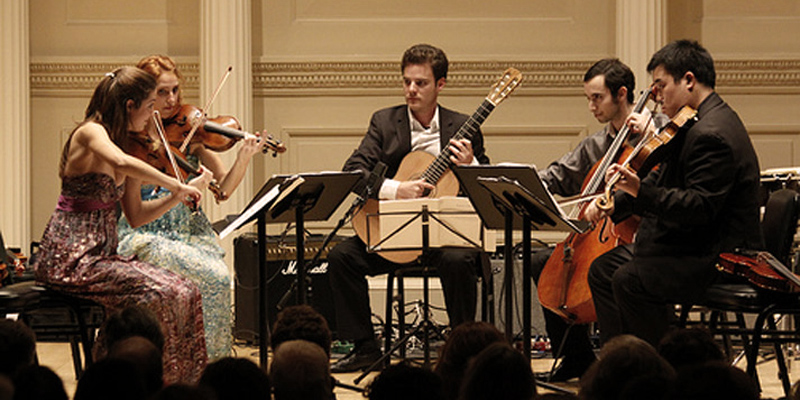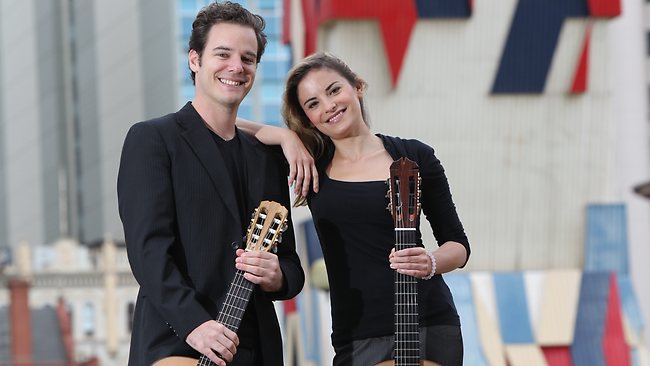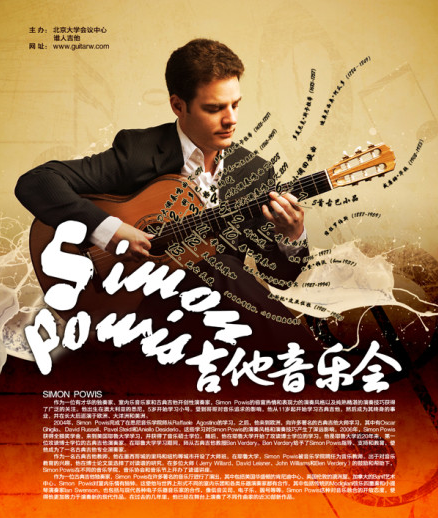- Musician (classical guitar, mandolin)
- Founder and Director of Powis Studios (Classical Guitar Corner, Syncopated City, CGC Publishing, Ukulele Corner, The Online Music Teacher)
- Co Founder of Didactica.io
- Podcast Host (Classical Guitar Corner Podcast, The Online Music Teacher Podcast)
- Doctorate from Yale University
- Board Member of the New York Classical Guitar Society
- Author of several books (CGC Publishing, Amazon)

International Concert Appearances:
- Carnegie Hall – New York
- GFA Symposium
- The Kennedy Center – Washington D.C.
- Australian International Guitar Festival
- Beijing – China (multiple tours)
- Banff Center for the Arts, in Canada
- Buenos Aires – Argentina
- Brugge – Belgium
- Boulder – Colorado
- Lima – Peru
- Oslo – Norway
- Queretero – Mexico
- Australia (multiple tours)
- Chile (tour with orchestra)
Featured classes and workshops:
- Cleveland Internation Guitar Festival
- Colorado University
- Yale University
- Sydney University
- Adelaide University
- The University of New South Wales
International masterclasses:
- Queretaro, Mexico
- Sydney, Melbourne and Perth, Australia
- Lima, Peru
- Beijing, China
- All over the United States
- Cleveland Internation Guitar Festival
- Colorado University
- Yale University
- Sydney University
- Adelaide University
- The University of New South Wales


Reviews
On the evening of November 19, Simon Powis played guitar concert at Centennial Hall multi-purpose hall, takes audiences on a period of quiet elegance wonderful musical journey.
Simon Powis is a talented soloist, chamber musician and classical guitar groundbreaking performer. Holding his guitar onto the stage, very briefly say hello, and began playing – wonderful skilled in stark contrast to the sound of the piano with his short few words, the original guitar sound is more loud, more wonderful voice. ”
Simon Powis guitar concerts open musical journey. He first play is the the sweet light more than the United States, the famous Italian composer Nick Scarlatti creation “D Sonata K.491”. The cheerful tone feels like ride a light gallop on country roads foal, against the wind and the sun, swing repeated melody to make people feel stable and comfortable.Milan Kundera once said, “repeat is happiness.” Very appropriate expression for the music. The flexible switching more major audience a taste of Simon superb skill of playing skills.
The creation of the next two tunes by the outstanding Spanish composer Isaac Albeniz, he is of Spanish folk music introduced to Europe as well as the world audience a Spanish native composer, his music also by the Andalusian strongly influenced by folk music. Simon the night playing “Cordoba” and “Granada” is the name of two cities in Andalusia, southern Spain. Simon brief to Cordoba is a small city in the Andalusia region of southern Spain, the city has many beautiful tower, various bells hanging tower, it is a very strong religious atmosphere in the city, Cordoba is its specific description.
Subsequently, Simon seriously playing together, the beginning of the song is for the audience of the tower ringtones imitation, vivid, notes, outlines a Cheung Ning and mysterious town. When the audience is imagined myself walking one, the music suddenly ups and downs, like Cordoba had also had no noble glory – it was once the largest city in Western Europe in the clear!The music finally quiet, it was like the outline of the landscape of the city, and like recounting the history of the city.”Granada” is full of Mediterranean style, the sound of the piano for the audience to feel the sea breeze, beach, licking the feet of the waves … tweedle show two cities interpreting the world, with music, Simon wonderful playing audience for praise.
Simon Powis introduces viewers track background. The second half Simon play is a series of South American music. In the first group of five of the songs, “Cuba skit, Simon played the guitar even played the Dayton perfect strike the strings, strumming, hook string vibrato techniques into one, to win the audience bursts applause and cheers.
After authored by Brazilian composer Villa Lobos played “Prelude No. 1” and a group of Argentine tango music is actually an anti usual elegant and gentle – the audience could have been ready to feel the passion and unrestrained, did not expect Simon select and play the songs actually allow people to savor the quiet elegance of Latin America.
Simon guitar notes coming to a stop, the audience could not cease warm applause, accept their hospitality, Simon two encores played for everyone “happiness” and “Angel milonga”, the audience food for thought, have fun and go.
Photography: Wei Lai-shun
Editor: Zhang Jue
11月19日晚,Simon Powis吉他音乐会在百周年纪念讲堂多功能厅奏响,带观众踏上了一段优雅恬静的奇妙音乐旅程。
Simon Powis是一位有才华的独奏家、室内乐音乐家和古典吉他开创性演奏家。他抱着吉他走上台,非常简短地跟大家问好之后,便开始了演奏——技术纯熟的美妙琴声与他的简言少语形成鲜明对比,原来吉他之声才是他更为响亮更为美妙的“嗓音”。
Simon Powis吉他音乐会开启音乐旅程
他首先给大家弹奏的是著名意大利作曲家多美尼克•斯卡拉蒂所创作的甜美轻快的《D大调奏鸣曲K.491》。欢快的调子让人感觉仿佛骑上了轻驰于乡间小路上的小马驹,迎着风和着阳光,回旋反复的旋律让人感觉到安定舒适。米兰•昆德拉曾经说过“重复便是幸福”,这样的表达用于音乐上再合适不过。大调的灵活切换更是让观众领略了Simon高超娴熟的弹奏技艺。
接下来的两首曲子由西班牙杰出作曲家伊萨克•阿尔贝尼斯创作,他是把西班牙民间音乐介绍给欧洲以及世界听众的第一位西班牙本土作曲家,他的音乐创作也受到安达卢西亚民间音乐的强烈影响。Simon当晚演奏的《科多巴》以及《格拉纳达》便是西班牙南部安达卢西亚地区两座城市的名称。Simon向大家简单介绍,科多巴是西班牙南部安达卢西亚区的一座小城市,城中有很多漂亮的塔,塔上挂着各种铃铛,那是一座宗教气息很浓的城市,《科多巴》便是对它具体的描绘。
随后,Simon就认真弹奏起来,乐曲的开始便是对塔上铃声的模仿,惟妙惟肖,音符为听众勾勒了一座祥宁又神秘的小城。当听众们正想象着自己漫步其中时,乐曲突然开始起伏跌宕,像是在昭示科多巴曾经也有过无尚的荣光——它曾经一度是西欧最大的城市!乐曲最后又归于平静,它既像是勾勒城市的风景,又像在述说城市的历史。《格拉纳达》则充满了地中海风情,琴声让听众们感觉到了海风、沙滩、舔舐脚丫的海浪……用琴声展现两座城市,用音乐阐释世界,Simon美妙的演奏令观众大为赞叹。
Simon Powis为观众介绍曲目背景
下半场Simon为大家演奏的是一系列南美洲的乐曲。在第一组乐曲《5首古巴小品》中,Simon将吉他演奏中的连奏、顿奏、击弦、扫弦、勾弦、揉弦等技巧完美地融入其中,赢得了观众们的阵阵鼓掌和喝彩。
之后弹奏的由巴西作曲家维拉罗伯斯创作的《前奏曲1号》以及一组阿根廷探戈乐曲竟一反平常地雅致和缓——听众们本来都做好准备感受激情和奔放,没想到Simon选取和弹奏的乐曲竟让人们体味到了拉丁美洲的安静高雅。
虽然Simon吉他上的音符逐渐静止,观众却无法止息热烈的掌声,盛情难却,Simon两次返场为大家演奏了《幸福》和《天使米隆加》,令观众回味无穷,尽兴而归。
摄影:魏来顺
Edin Karamazov, with Simon Powis – Adelaide International Guitar Festival 2012
Reviewed Saturday 11th August 2012
Simon Powis was not, as some of the other supporting artists seem to
have been, a warm up act for the main artist. He is a great performer
in his own right, and a fascinating counterpoint to Edin Karamazov. He
opened with a most unusual piece, Benjamin Verdery’s Satyagraha,
adapted from an Indian raga and occasionally incorporating short
passages of that raga, even sounding, during those sections, quite
like a sitar, thanks to his enviable performance skills.
On more familiar ground, he then played Isaac Albéniz’s Córdoba, Op.
232, no.4, his musical portrait of the Andalusian city, with its
opening reference to the Great Mosque of Córdoba. His technique is
marvellous but, more importantly, he captured the Romantic mood of the
piece beautifully. A technically challenging piece from Armand Coeck,
Constellations, brought us to South America again, with Baden Powell’s
Samba em Preludio and Antonio Carlos Jobim’s Felicidade. That was a
very good choice to close his part of the concert, both as a chance
for us to see how much warmth he injects, and the dynamic range that
he employs in these pieces, giving them a distinct interpretation of
his own.
…
Arts Global in New York
Reviewed in the Huffington Post – 10th October 2011
I was particularly impressed with Simon’s mastery of the classical guitar. Simon displayed outstanding sensitivity and a musical maturity that was worthy of any professional concert platform. I know we will be hearing much more from this young man, who now resides in New York.
Adelaide International Guitar Festival
Reviewed Sunday 12th August 2012
This concert featured the Australian String Quartet and four of the
marvellous guitarists who have appeared in this Festival, taking it in
turns to join with the Quartet to play a number of old and new string
quintets. The Quartet has been a part of the music scene since 1985
and have performed around the world to critical acclaim, as well as
being the Quartet in residence at the University of Adelaide. Kristian
Winther and Anne Horton, violins, Stephen King, viola, and Rachel
Johnston, cello, are the current members of the Quartet, with Winther
and King joining the group this year. They have established themselves
as one of the finest quartets and their performance of the works in
this programme demonstrated why they are in demand.
Slava Grigoryan was first to join the Quartet, for a performance of
Mario Castelnuovo-Tedesco’s Guitar Quintet, Op. 143 from 1950. This is
a beautifully lyrical piece in which there is a superb integration of
the guitar part. Most of the major guitarists have recorded this work,
such is its appeal. Grigoryan’s exceptionally expressive playing was a
delight and made this one of the better performances, by far, of this
work. He and the Quartet seemed to be thinking as one in a beautifully
balanced performance. No wonder he was chosen to run this Festival.
Simon Powis chose Australian composer Phillip Houghton’s In Amber for
his collaboration with the Quartet. As one might expect, this work
calls for a few of the more modern playing techniques from the Quartet
to express the composer’s ideas. Complex harmonic ideas abound in the
three movements, and some rather angular melody lines. Houghton makes
good use of silences, too, for heightened dramatic effect. There are
also some very melodic passages in the work, as well as a chance for
the viola to shine here and there. Powis again demonstrated his great
technical ability, as well as his musicality, in this challenging
piece.
Ana Vidovic opened the second half by repeating her solo performance
of Asturias, by Isaac Albéniz, that was a very popular piece in her
own concert, then joined with the Quartet to play the final movement,
Fandango, from Luigi Boccherini’s 1788 arrangement of one of his
earlier works, the Guitar Quintet No. 4 in D Major, G. 448. Boccherini
wrote a copious collection of string quartets and quintets, of one
sort or another, and his cello parts are well worth listening out for
as he was, of course, a cellist as well as a composer. Vidovic’s
delicate touch suited the piece perfectly, and balanced just as well
with the excellent work of the Quartet.
Edin Karamazov then turned to the Beatles, playing seven of their best
known numbers, arranged by Cuban composer Leo Brouwer into a suite he
calls simply, Quintetto. Although arranged for a Guitar Quintet, this
was no dull rendition with all of the life drained from it, in an
attempt to turn it into something very serious. All of the original
feeling of the tunes was there, brought out clearly and joyously by
Karamazov. The playing order actually differed from that in the
programme, beginning with the poignant, She’s Leaving Home. There were
the well known songs, such as Got to Get You Into My Life, Eleanor
Rigby, and Yesterday, as well as those less often heard such as She’s
Leaving Home, and the aforementioned opening song. A sensitive
approach to Penny Lane ended the performance and the concert.
Karamazov captured the Beatles youthfulness and exuberance
marvellously in these terrific arrangements.
Reviewed by Barry Lenny, Arts Editor, Glam Adelaide.


